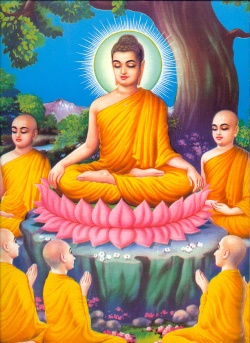Vibhajyavāda
vibhajyavāda; A school of thought doctrinally opposed to the Sarvāstitvāda. It holds that the present dharma-s alone exist. However, some among them like the followers of the Kāśyapīya, concede that the past karma that have not yet given fruit (adatta-phala) can also be said to exist.
Vibhajyavāda (Sanskrit; Pāli: Vibhajjavāda; traditional Chinese: 分別說部; pinyin: fēnbiéshuō-bù) was an early Buddhist school or a group of early Buddhist schools. (Pāli). ‘The Distinctionists’. A school of early Buddhism belonging to the Elder (Sthavira) tradition, which at the Council of Pāṭaliputra in c.250 ce (see Council of Pāṭaliputra II), was adjudged to embody the orthodox teachings of the Buddha. It is unclear, however, whether the Vibhajjavādins comprised one sect or a group of sects, and the precise nature of the movement and its doctrines and duration remain obscure. Since the Buddha is sometimes referred to in Pāli sources as a ‘Distinctionist’ (vibhajjavādī), the appellation may be an alternative designation for the Theravāda school. The ‘distinction’ in question may refer to the Buddha's basic methodological practice of making a ‘distinction’ between extremes and emphasizing the Middle Way (madhyamā-pratipad), but this interpretation of the origin of the term is conjectural.
Nomenclature and etymology
The word Vibhajyavāda may be parsed into vibhajya, loosely meaning "dividing", "analyzing" and vāda holding the semantic field: "doctrine", "teachings". According to Andrew Skilton, the analysis of phenomena (Skt. dharmas) was the doctrinal emphasis and preoccupation of the Vibhajyavādins.
History
The Vibhajyavādins are not recorded uniformly by early Buddhist traditions as being a distinct sect, nor being associated with any one period of time.[3] The Theravādin Kathāvatthu does not contain any reference to a Vibhajyavāda school, but the Sammatīyas and the Mahāsāṃghika do mention the Vibhajyavādins, albeit in different ways. According to the Sammatīya sect, the Vibhajyavādins developed from the Sarvāstivāda school. However, the Mahāsāṃghikas saw the Vibhajyavādins as being offshoots from the root schism in Buddhism, which according to them produced three sects: the Sthaviras, the Mahāsāṃghikas, and the Vibhajyavādins. The Mahāsāṃghikas then list the Mahīśāsaka, Dharmaguptaka, Kāśyapīya, and Tāmraparnīya sects as having descended from the Vibhajyavādins.
The Sarvāstivādin Abhidharma Mahāvibhāṣa Śāstra describes the Vibhajyavādins as being the type of heretics who "make objections, who uphold harmful doctrines and attack those who follow the authentic Dharma".
Some scholars believe that there was no separate "Vibhajyavāda" sect, but that the term vibhajyavāda was sometimes affixed to the name of a school to indicate that it differed from the main school on some doctrines. In this sense, they would be vibhajyavādins of that particular school. This is also found in the Mahāsāṃghika branch with the Prajñaptivāda school, whose members preferred to be called Bahuśrutiya-Vibhajyavādins. It has been suggested that the Theravādins of Sri Lanka may have been Sthavira-Vibhajyavādins, differing somewhat from the main Sthavira school in their doctrinal interpretations.
In Theravāda traditions
The Third Buddhist Council, under the leadership of Moggaliputta Tissa emphasized this analytical approach.[citation needed] Some sub-divisions of Sthavira school which adopted this approach were regrouped and termed as the followers of Vibhajjavāda. Those not included in the Vibhajjavāda group were the Mahāsāṃghikas, Sarvāstivāda and Sammitīya, who were regarded as having the ‘wrong view’ by the Vibhajjavādins, according to the Theravadin Kathavatthu, a work ascribed to Moggaliputta Tissa.
The Theravada tradition holds that after the Third Council, the Vibhajjavādins evolved into four groups: the Mahīśāsaka, Kāśyapīya, Dharmaguptaka, and the Tāmraparnīya. Theravada is descended from the Tāmraparnīya, which means 'the Sri Lankan lineage'. On the other hand, some sources suggest that Mahīśāsaka, Kāśyapīya and Dharmaguptaka did not evolve directly from the Vibhajjavādins, although an original connection between these groups is posited due to the similarities of their respective Vinayas.
The Vibhajjavadins are claimed to have seen themselves as orthodox Sthaviras.
According to Sinhalese tradition, Buddhism under the name of Vibhajjavāda was brought to Sri Lanka by Mahinda, who is believed to be the son of Emperor Asoka, an event dated by modern scholars to 246 BCE
